Gently caressed with oak smoke and then reverse seared in a screaming hot cast-iron skillet, this thick-cut, bone-in Smoked Ribeye Steak is bold and savory with a big beefy flavor.
Whether you are a hardcore carnivore or just love ribeyes, you will appreciate the aromatic and delicious smoky flavor that permeates the meat, and the right balance of simple seasonings, which come together to produce the perfect slow-smoked steak.

With this smoked ribeye steak recipe, tender and juicy steaks are slowly smoked over low heat and then quickly seared over high heat, which gives them a nice crust and seals in their juices.
And, the best part is whether you have a Big Green Egg, Traeger, Master Built, or even a Weber Kettle Grill, any type of covered grill or smoker works with this recipe.
Whether you use charcoal, wood, gas, or wood pellets for fuel, all are excellent. You will quickly learn that slow smoking a steak with a rich smoky flavor couldn’t be easier!
Jump to:
Ingredient notes:

- Ribeye steaks – are the king of steaks. Beautifully marbled with a wonderful taste and tender texture, thick cut or ribeye roasts are perfect for this recipe or my Reverse Seared Ribeye Steak in the Oven.
- Kosher salt – enhances the flavor and brings all of the beefy flavors together.
- Ground black pepper – works with its partner salt to enhance the flavors.
- Garlic powder – is an optional seasoning, but I think just a bit adds great flavor.
- Peanut oil – is used to coat the cast-iron skillet and keep the steak from sticking.
Step-by-step directions:
- Follow the manufacturer’s directions and set up your grill or smoker for indirect cooking. Preheat it to 250 °F. Next, add wood chips that have been soaked or dry wood chunks directly onto the coals.
- Season the steaks on both sides with salt, pepper, and, optionally, a bit of garlic powder.

- Brush the grill grates with oil to prevent sticking and add the steaks. Close the lid.
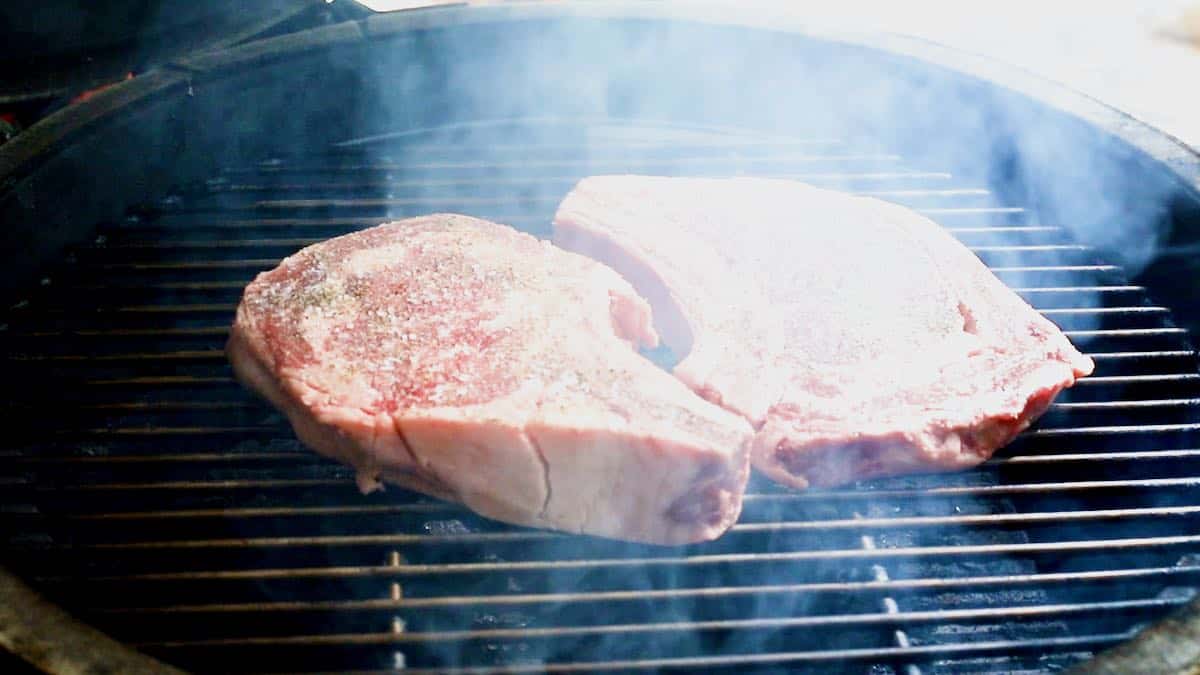
- Let the steaks smoke on the grill until they reach an internal temperature of 125 °F for medium-rare. Measure the temperature with an instant-read meat thermometer in the thickest part of the meat, not touching the bone.

- Remove the steaks from the grill or smoker. To reverse sear them, heat a large cast-iron skillet on the stove over high heat for at least five minutes or until it is screaming hot.
- Add about two tablespoons of peanut oil and rotate and tilt the skillet to coat the bottom with oil.
- Add the steaks to the cast-iron skillet and pan-sear them for approximately one to two minutes on each side or until they reach the desired final temperature. For medium-rare, that is 130 °F.
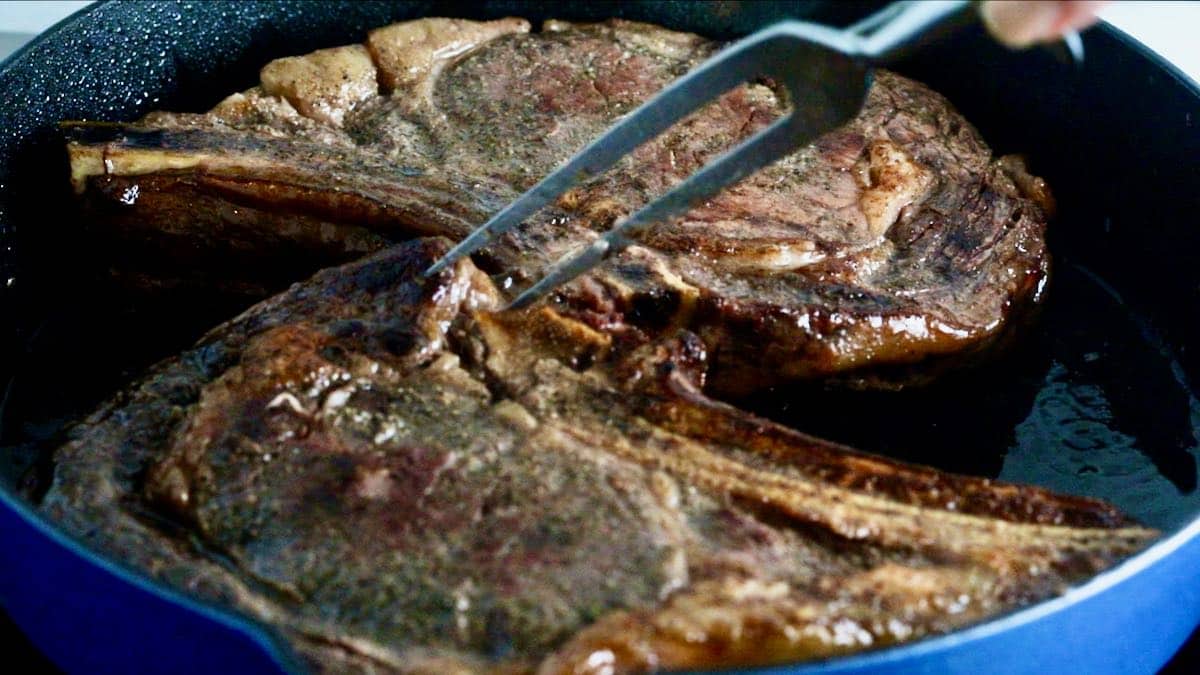
- Remove the steaks, cover them loosely with foil and let them rest for five to ten minutes before serving. Typically, the temperature of the steak will rise three to four degrees while it is resting.

Best side dishes to serve with this recipe:
I like to serve either my Classic Southern Potato Salad, Twice Baked Potatoes, Easy Creamed Potatoes, or Grilled Vegetable Kabobs with smoked ribeye steaks.
Smoked steak would also pair nicely with my Southern Cucumber and Tomato Salad, Easy Southern Corn Salad, Smoked Baked Beans, Smoked Sweet Potatoes, or Southern Broccoli Salad.
Recipe variations:
The beauty of this smoked ribeye steak recipe is its simplicity. However, if you would like to kick things up a notch, you could serve them topped with my Garlic Herb Butter or Maple Bourbon Butter. They would also be wonderful topped with either Onion Blue Cheese Sauce or Gorgonzola Sauce.
Recipe FAQs:
Ribeye steaks are so flavorful you don’t need much seasoning. A sprinkle of salt and pepper, and if you like, a bit of garlic powder, are all you need.
However, if you prefer, you can use your favorite dry rub or steak marinade. If you do decide to marinate the steaks, they will need to be patted dry before smoking.
It all depends on how thick your steaks are, what the internal temperature is when they are placed on the grill or smoker, and the temperature of your smoker.
That’s why it is important to smoke to a specific internal temperature and not for an exact amount of time. In most cases, it will typically take anywhere from 20 minutes to one hour.
If you want a perfectly cooked steak every time, an instant-read meat thermometer is essential. From simple to sophisticated, there is one to fit every budget.
Always insert the probe in the thickest part of the meat, not touching the bone.
-For medium-rare, remove the ribeyes from the smoker when the internal temperature reaches 125 °F, reverse sear them until they reach 130 °F, and let them rest until they come up to 135 °F.
-For medium, remove the ribeyes from the smoker with the internal temperature reaches 135 °F, reverse sear them until they reach 140 °F, and let them rest until they come up to 145 °F.
-For medium-well, remove the ribeyes from the smoker when they reach 145 °F, reverse sear them until they come up to 150 °F, and let them rest until they come up to 155 degrees °F.
No, they do not need to be flipped because the smoke completely surrounds them and permeates the meat.
Beef can take a stronger smoke than chicken, fish, or pork, so I generally like to use oak. However, any mild-flavored fruitwood such as apple, peach, or pear or an even stronger flavored wood such as hickory or mesquite will also work.
Sharon’s tips:
- This recipe works perfectly on any covered grill or smoker. If you use a covered grill, pile up your fuel on one side of the grill and place the steaks on the other side. For other types of grills or smokers, follow the manufacturer’s directions for smoking and indirect cooking.
- I smoke my steaks on a Big Green Egg using the plate setter, sometimes called a ConvEGGtor, for this recipe and then reversed seared them in a cast iron skillet. If you prefer, after the steak has finished smoking, you can carefully remove the plate setter, increase the heat to 500 °F and sear the steaks on the BGE instead of reverse searing on the stove.
- Ribeye steaks are my favorite, but you can substitute any steak, including filet mignon, New York strip, sirloin, t-bone, or porterhouse, as long as they are thick enough. You can even use this recipe for the popular, larger tomahawk or cowboy ribeyes.
- This recipe specifies kosher salt. If you use regular table salt, reduce the amount by one-half.
- This recipe works best with thick-cut ribeye steaks or ribeye roasts that are at least one and a half inches thick or thicker. Thinner steaks will dry out.
More recipes for the smoker or grill:
If you like to smoke or grill outside as we do, you may also like these top-rated favorites:
Here are a few more reader favorites:
Smoked Beef Short Ribs, Smoked Shrimp, Easy Grilled Beer Can Chicken, Double Smoked Ham, and Grilled Bone-In Pork Chops.
For a great appetizer, try my Smoked Queso. For more ideas, check out all of my grill and smoker recipes.
★ ★★★ ★If you make this recipe, please leave a comment and give it a star rating. I would love to know how you liked it!
Thank you so much for visiting Grits and Pinecones; I hope you come back soon!
📋 Recipe:
Want to Save This Recipe?
Enter your email & I’ll send it to your inbox. Plus, get great new recipes from me every week!
By submitting this form, you consent to receive emails from Grits and Pinecones.
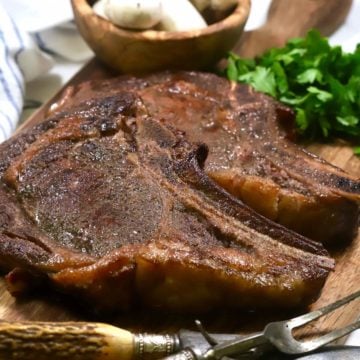
Smoked Ribeye Steak (Reverse Seared)
Equipment
- Covered grill or smoker
- Instant-read meat thermometer
Ingredients
- 2 ribeye steaks or ribeye roasts bone-in, 1½ inches thick or thicker
- 1 teaspoon kosher salt
- 1 teaspoon ground black pepper
- 1 teaspoon garlic powder optional
- 2 tablespoons peanut oil or another vegetable oil
Instructions
- Follow the manufacturer's directions and set up your grill or smoker for indirect cooking. Preheat it to 250 °F. Next, add wood chips that have been soaked or dry wood chunks directly onto the coals.
- Season the steaks on both sides with salt, pepper, and, optionally, a bit of garlic powder.
- Brush the grill grates with oil to prevent sticking and add the steaks. Close the lid.
- Let the steaks smoke on the grill until they reach an internal temperature of 125 °F for medium-rare. Measure the temperature with an instant-read meat thermometer in the thickest part of the meat, not touching the bone.
- Remove the steaks from the grill or smoker. To reverse sear them, heat a large cast-iron skillet on the stove over high heat for at least five minutes or until it is screaming hot.
- Add about two tablespoons of peanut oil and rotate and tilt the skillet to coat the bottom with oil.
- Add the steaks to the cast-iron skillet and pan-sear them for approximately one to two minutes on each side or until they reach the desired temperature.
- Remove the steaks, cover them loosely and let them rest for five to ten minutes before serving. Typically, the temperature of the steak will rise three to four degrees while it is resting.
Notes
- For medium-rare, remove the ribeyes from the smoker when the internal temperature reaches 125 °F, reverse sear them until they reach 130 °F, and let them rest until they come up to 135 °F.
- For medium, remove the ribeyes from the smoker with the internal temperature reaches 135 °F, reverse sear them until they reach 140 °F, and let them rest until they come up to 145 °F.
- For medium-well, remove the ribeyes from the smoker when they reach 145 °F, reverse sear them until they come up to 150 °F, and let them rest until they come up to 155 degrees °F.
- This recipe works well on any type of covered grill or smoker. If you use a covered grill, pile up your fuel on one side of the grill and place the steaks on the other side. For other types of grills or smokers, follow the manufacturer’s directions for smoking and indirect cooking.
- I smoke my steaks on a Big Green Egg using the plate setter, sometimes called a ConvEGGtor, for this recipe and then reverse seared them in a cast iron skillet. If you prefer, after the steak has finished smoking, you can carefully remove the plate setter, increase the heat to 500 °F and sear the steaks on the BGE instead of reverse searing on the stove.
- Ribeye steaks are my favorite, but you can substitute any steak, including filet mignon, New York strip, sirloin, t-bone, or porterhouse, as long as they are thick enough. You can even use this recipe for the popular, larger tomahawk or cowboy ribeye steaks.
- This recipe specifies kosher salt. If you use regular table salt, reduce the amount by one-half.
- This recipe works best with thick-cut ribeye steaks or ribeye roasts that are at least one and a half inches thick or thicker. Thinner steaks will dry out.


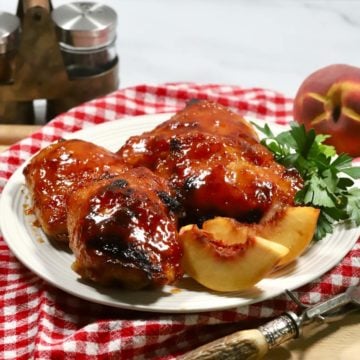
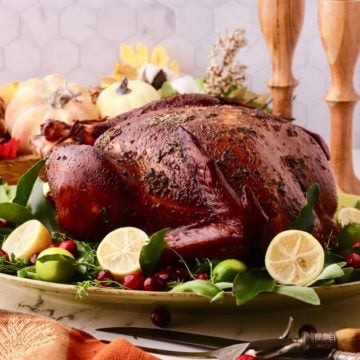
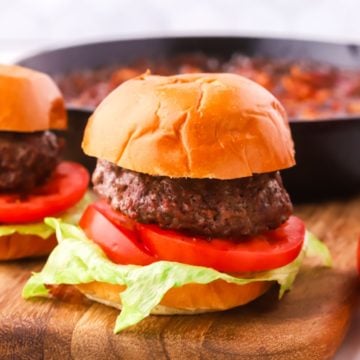
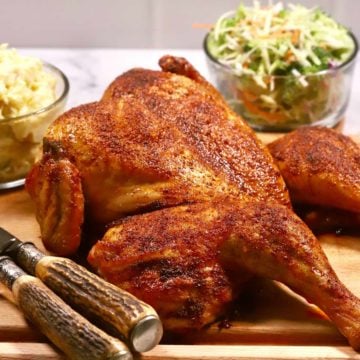
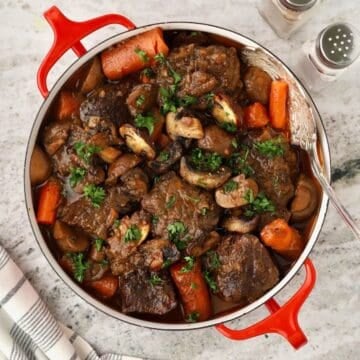
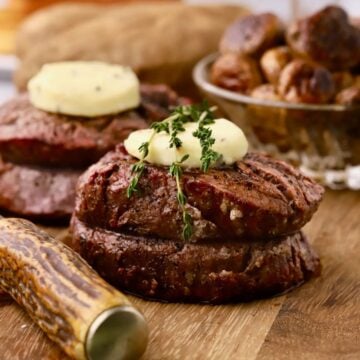



Carolyn
Goodness, this made my mouth water and it sounds delicious. I have two ribeye’s in the fridge right now. WEH got them from the Farmers Market out Thomasville RD. The meat guy is from GA and we have never tried his meats but I’ll let you know how we liked them.
Carolyn
Sharon Rigsby
Hey Carolyn,
I hope you enjoy them!